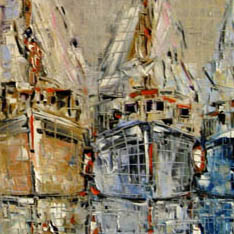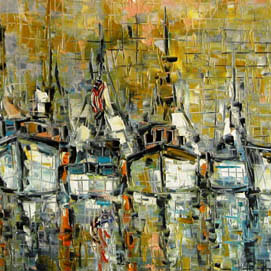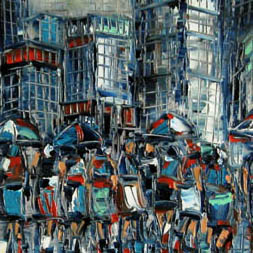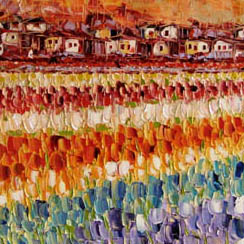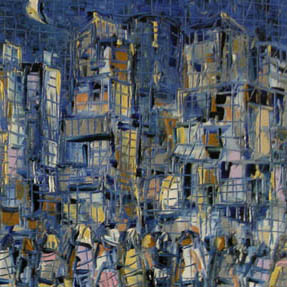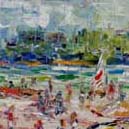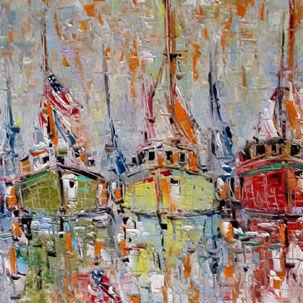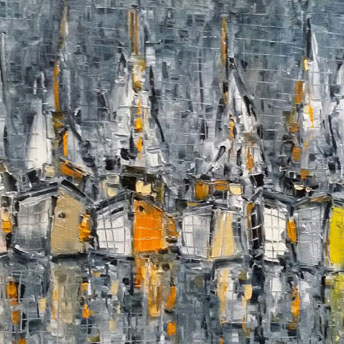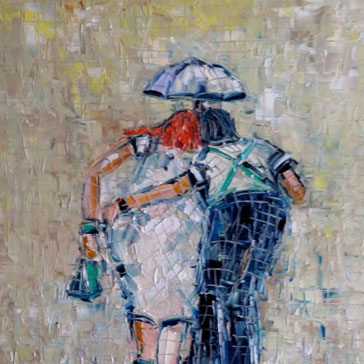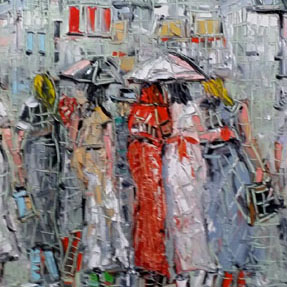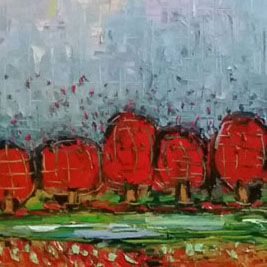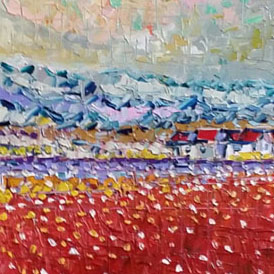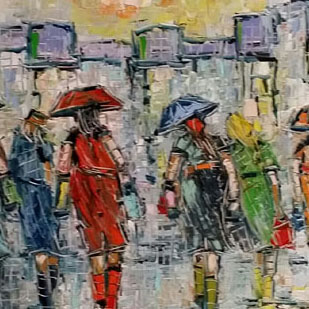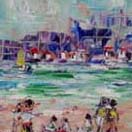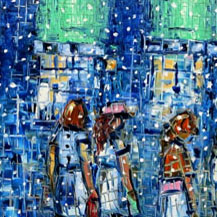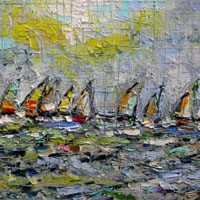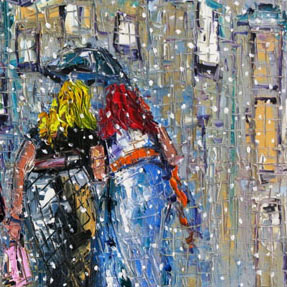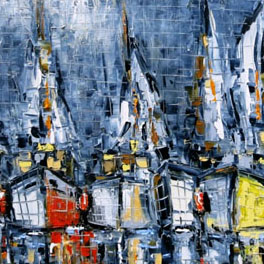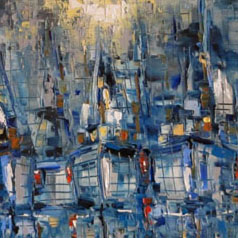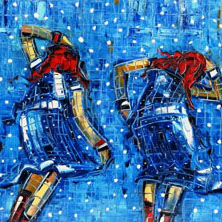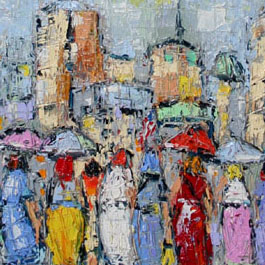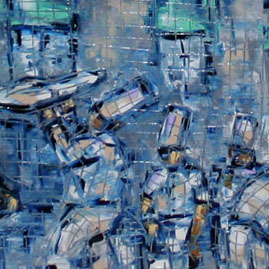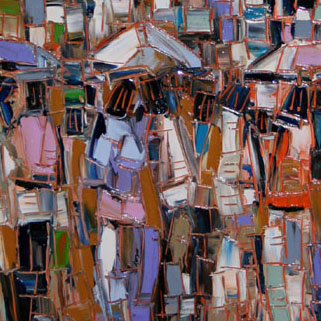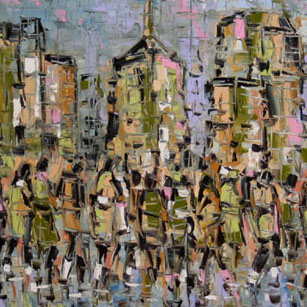|
1859 Oregon Magazine, January 2014
Joachim McMillan uses oils to spice up the Oregon art scene By: Ben Opsahl/Contributing Writer
The blue-grey cityscape marked by tilted squares of sunlight and scarlet umbrellas does not exist, but Joachim McMillan will take you there nonetheless. He will introduce you to a thousand dancing women he has never met and take you out to sea on a sailboat he has never sailed.
“All of my work is imaginative,” says McMillan, a Beaverton resident who has been painting since he was a boy growing up in the Caribbean. “There is no specific place or subject. Everything comes together from my experiences, like different seasonings.”
A child of Grenada, the “island of spices,” McMillan is entirely self-taught, and his style, eclectic. His most outstanding scenes blend a complete image with fragmentation and sectioning lines in a style he calls “oil mozayic.” The result is a recognizable motif that renders his paintings familiar yet distinct.
After getting his feet wet painting beach scenes in watercolor and acrylic for local shops in Grenada, McMillan put painting on hold and took the long way to Oregon. He first made a break for New York at age 21, eventually finding work as a semiconductor technician for Intel in Massachusetts. The rapid pace of the city left little time for art.
“When I first came to New York, I wasn’t painting at all,” he says. “It was never on my mind. I would do one or two paintings a year, just to keep in touch with myself, but that was it.” He considers himself lucky to have found an opportunity in Oregon during a restructuring at Intel in 2005.
Once settled, his urge to paint resurfaced.
“Portland broke me out,” he recalls. “I decided to start painting again because of the galleries.” He cites Portland’s First Thursday monthly art walk in the Pearl District as being particularly cathartic. “It fosters the artwork— seeing all these people walking from gallery to gallery. That sent me back to the drawing board.”
Cannon Beach, Mt. St. Helens and the drive along Highway 26 quickly became his muses.
With newfound spirit and a palette knife in hand, McMillan began testing different styles, working extensively with long strokes of thick paint to portray a sense of action. Those early efforts earned him a 2005 showing at the Gallerie René in downtown Portland, effectively marking the start of a professional career still defined by experimentation.
McMillan makes frequent trips to galleries on the coast, with current showings at the Modern Villa Gallery in Cannon Beach, Silver Heron in Depoe Bay and Ryan Gallery in Lincoln City. His work can also be found at the Forever Art gallery in downtown Portland.
McMillan’s paintings were recently shown at the 2013 Ann Arbor Art Fair in Michigan, and he has enjoyed dozens of similar opportunities in places such as Naples, Toronto and Chicago. His life story and personality add intrigue at events where he is showing his work. His accent is distinct and pleasant, he speaks frankly and punctuates most sentences with a smile.
“I’m a Rasta man,” he says, lifting his hat to reveal dreadlocks that he has since cut. “For a lot of people, my Caribbean background is part of the experience. It appeals to them. Then people see Beaverton, and that turns heads. They say, ‘Wow, this is the art that comes from Oregon?’”
By Gabriel Kiley, Managing Editor, Art Business News, March, 2010
Joachim McMillan’s paintings are defined by a sense of movement that lures viewers into his art. That feeling of being on the move is certainly reflective of the artist’s life journey, which started with growing up on the tiny island of Grenada.
Joachim McMillan was born in Grenada, moved to New York in his 20s, and now resides in Oregon.
Inspired by his father, the self-taught artist started painting with watercolors and acrylics for galleries, and he also drew cartoons for two of the Caribbean island’s main newspapers as a teenager. By his early 20s, McMillan relocated to New York to study technology and to continue exploring different art techniques, and in 2006, he moved across the country to Beaverton, Ore., where his art career is now blossoming.
“I started to get some attention in local galleries and things really took off for me,” said McMillan, 38, whose paintings are now sold in more than 10 galleries, mostly in Oregon, but also in the state of Washington, Pennsylvania, Virginia, Barbados and Grenada. McMillan juggles his art career with his job at a semiconductor company.
Even more, McMillan’s artwork will be on display at the 32nd annual International Artexpo March 25 to 28 in New York. This will be his third Artexpo show after making appearances at the New York and Las Vegas events two years ago.
“As an emerging artist, Joachim continues to grow and to mature as a painter,” says Pamela Brown, co-owner of ArtJaz Gallery, Philadelphia, which carries McMillan’s paintings. “As he continues to incorporate his experiences from his native home, Grenada, living in the United States and his personal experiences, there is much anticipation about his future as a painter.”
Two Distinctive Styles McMillan’s paintings reflect two distinctive styles: pixelism and impasto freestyle.
McMillan defines pixelism as a contemporary style of painting inspired by the digital imaging used in computer technology and characterized mainly by presentation of an image whose surface has been fractured into a distinct configuration of squares. The end result: a mosaic arrangement of texture, pattern and color. He adds that pixelism is a manner of painting with the characteristic appearance of a broken surface in which the subject is presented in a fragmented state. When the artist breaks down the painted surface into small areas using texture, color and pattern, he thereby creates a multi-faceted effect similar to stained glass.
Impasto freestyle, on the other hand, is a style characterized by its carefree strokes with the palette knife (or brush) and thick paint application. McMillan says it is an “outstanding expression” of how free the artist applies strokes in a carefree or loose manner, thus creating a constructive image that portrays action in viewers’ eyes.
“Joachim has mastered the palette knife,” says Stephanie Valvez, sales director of Gallerie Rene’ in Portland, Ore.
The subjects of McMillan’s paintings —women, beach scenes, cityscapes, dancers, sailboats, etc.—lend themselves to the sense of movement that McMillan creates in his paintings. (The artist also paints landscapes, namely woods, mountains and farm fields.)
“I want my art to have motion,” McMillan says. “I want something active that reveals something all the time.”
Beverly Dawson, co-owner of ArtJaz Gallery in Philadelphia, says her collectors are “intrigued by Joachim’s use of the palette knife that creates constant motion and rhythm in his paintings.”
“There’s an authenticity that comes through in his work,” she says. “The passion and energy he feels is conveyed to the collector which provokes thought and emotion.
“Joachim has the ability to take common elements that people are familiar with like sunsets, couples and marina and beach scenes and express them in his own unique technique that he calls ‘the rain drop effect,’ which creates an illusion of motion. Although his subjects are universal, it is his approach with color manipulation, texture and pattern that distinguishes his work.”
McMillan says he’s continually inspired by his surroundings, his past experiences and feedback he gathers from collectors and gallery owners. For instance, the aforementioned “rain-drop effect” in his paintings is inspired by the damp climate of the Pacific Northwest.
“I’m constantly thinking about new compositions, exploring new styles and experimenting with new techniques,” he says. “I paint with images and memories from my mind.”
Thinking Big Valvez says McMillan is one of her gallery’s top-selling artists, primarily because of his ability to create movement, to incorporate vivid colors and to work with the palette knife. She says the artist has a bright future in the art world.
“Collectors love him,” she says. “He’s so well-rounded.”
Brown of ArtJaz Gallery says McMillan offers “great promise” as his career continues to evolve this decade.
“Even in a crowded art market, there is always room for an artist that has fresh ideas and can communicate that through their art with passion and enthusiasm,” she says.
Even as an artist on the move, McMillan keeps a singular goal: to paint with purpose in order to “impact the art world in a powerful way.”
“I want to change the art market,” he says.
- BACK TO TOP
|

